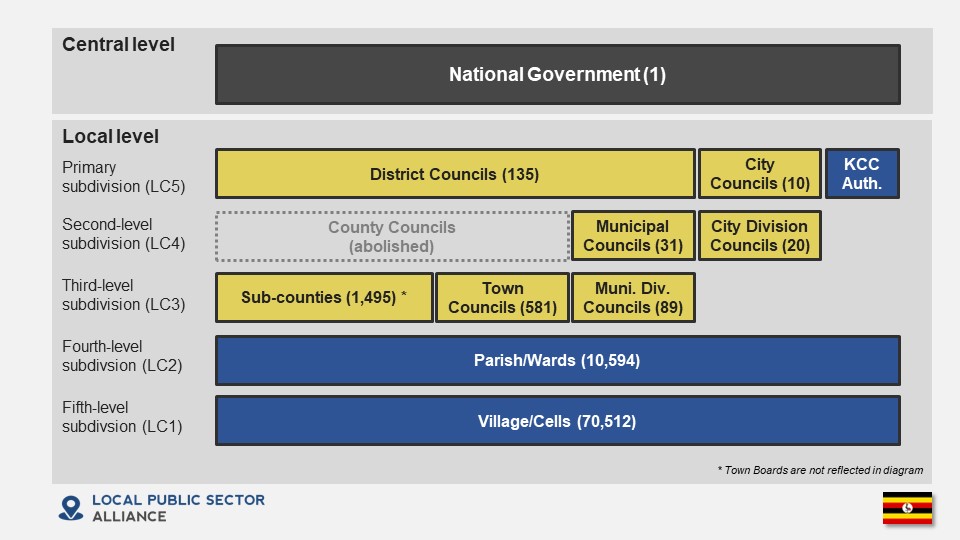
Uganda is a unitary republic in Eastern Africa. The country’s intergovernmental architecture is based on directives principle and provisions contained in the 1995 Constitution, which indicates that the State “shall be guided by the principle of decentralisation and devolution of governmental functions and powers to the people at appropriate levels where they can best manage and direct their own affairs.” The constitution further specifies that the local government system is based on district units, under which there shall be such local governments and administrative units as provided for by national legislation. In practice, local governance in Uganda is structured across five levels, ranging from the District and City Councils level (immediately below the national government) to Villages and Cells closest to the people. Local governments deliver a wide range of basic services, including primary education, healthcare, roads, water supply and agricultural extension services. In practice, however, local governments in Uganda have limited autonomy, due to the central government maintaining significant budgetary and administrative control over their activities, as well as through sector policies, standards and intergovernmental grant arrangements which are prescriptive and significantly limit local discretion.
Subnational government structure
Uganda has a multi-level system of governance organized at national and local levels. The Local Government Act (1997, as amended) sets out the territorial-administrative structure of the country into five levels across urban and rural areas, consisting of 135 District and 10 City Councils at the first level of subdivision (LC5); 31 municipal and 20 city division councils (LC4); 1,495 sub counties, 581 town councils and 89 municipal division councils (LC3); 10,594 Parishes/Wards (LC2); and 70,512 Villages/Cells (LC1). In 2011, the governance of Uganda’s Capital, Kampala, was transferred from Kampala City Council to the Kampala Capital City Authority (KCCA).
Nature of subnational governance institutions
Local governments and lower local governments in Uganda fall under the category of “hybrid” subnational governance institutions. The political organ at the center of all subnational entities is the council, whose members are elected in regular elections. Following a Constitutional amendment in September 2005, the right to hire and fire district chief administrative officers (CAOs) reverted to central government. Local governments finance their constitutionally mandated responsibilities from their own sources of revenues and various (often tightly earmarked) conditional grants from the national government and development partners. Although the constitution articulates that local governments are fully devolved entities, de facto they are not, due to several restrictions on their autonomy and decision-making powers imposed by higher levels of government. On the fiscal side, these include the requirement for local budgets (including own source revenues) to be approved by higher levels of government and the extensive use of conditional transfers that limit budgetary discretions. On the administrative side, local governments are unable to appoint their own CEO (they appointed by the central government) nor determine their own organizational structure. Furthermore, in practice, local government staff are subject to dual subordination to the central government as well as their respective local entity.
Functional assignments
The legal assignment of functions and expenditure responsibilities to local governments is provided by the Constitution and the Local Government Act (1997). The second schedule of the Local Government Act lists the functions that remain with the national government and those assigned to local governments. In practice, the assignment of functions at local government levels is determined to a large degree by conditional grant financing arrangements as well as sector specific laws and guidelines. These include a variety of grants for wages and non-wage recurrent activities, as well as development grants and donor funded activities. Despite their limited autonomy, local governments play an important role in public service provision and are responsible for major functions and services including primary education; healthcare; construction and maintenance of roads; water supply; agricultural extension services, land administration and surveying; and community development. However, there are some functions assigned to LGs that de facto remain at the central government level. For instance, secondary education, where the recruitment, appraisal and discipline of teachers is retained by the central government.
LoGICA Assessment
LoGICA Intergovernmental Profile: Uganda 2023 (Excel)
Selected resources
Uganda Country Profile (World Observatory on Subnational Governance and Investment, OECD/UCLG)
The Local Government System in Uganda (Commonwealth Local Government Forum)
Local government country profile: Uganda (UN Women)
Back to Local Public Sector Alliance Intergovernmental Profiles – Country Page
Last updated: December 29, 2023


